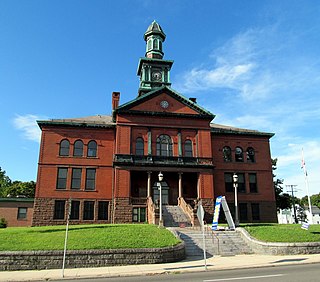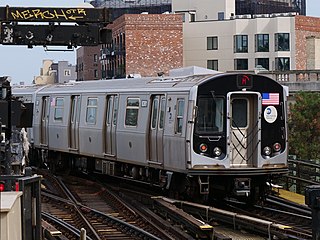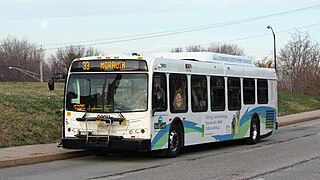
Windham County is one of the eight historical counties in the U.S. state of Connecticut, located in its northeastern corner. As of the 2020 census, the population was 116,418, making it the least populous county in Connecticut. It forms the core of the region known as the Quiet Corner. Windham County is included in the Worcester, MA-CT Metropolitan Statistical Area, which is also included in the Boston-Worcester-Providence, MA-RI-NH-CT Combined Statistical Area. The entire county is within the Quinebaug and Shetucket Rivers Valley National Heritage Corridor, as designated by the National Park Service.

The 4 Lexington Avenue Express is a rapid transit service in the A Division of the New York City Subway. Its route emblem, or "bullet", is colored forest green since it uses the IRT Lexington Avenue Line in Manhattan.

Milton GO Station is the western terminus of GO Transit's Milton line in the Greater Toronto Area, Ontario, Canada. It is located at 780 Main Street East in the Town of Milton, near Main Street and Ontario Street.

The M Sixth Avenue Local is a rapid transit service in the B Division of the New York City Subway. Its route emblem, or "bullet", is colored orange since it uses the IND Sixth Avenue Line in Manhattan.

Interstate 395 (I-395) is an auxiliary Interstate Highway in the U.S. states of Connecticut and Massachusetts; it is maintained by the Connecticut Department of Transportation (CTDOT) and the Massachusetts Department of Transportation (MassDOT). Spanning nearly 67 miles (108 km) on a south–north axis, it is the only spur route of I-95 in Connecticut. The 36-mile (58 km) section between its splits from I-95 in East Lyme and Connecticut Route 695 in Plainfield is a component highway of the Connecticut Turnpike. Within that state, the highway is named the American Ex-Prisoner of War Memorial Highway from Plainfield to Thompson.

The Memphis Area Transit Authority (MATA) is the public transportation provider for Memphis, Tennessee. It is one of the largest transit providers in the state of Tennessee; MATA transports customers in the City of Memphis and parts of Shelby County on fixed-route buses, paratransit vehicles, demand-responsive service, and the MATA Trolley system. The system is managed by a seven-member policy board appointed by the mayor and approved by the Memphis City Council. In 2022, the system had a ridership of 3,204,000.

Connecticut's 2nd congressional district is a congressional district in the U.S. state of Connecticut. Located in the eastern part of the state, the district includes all of New London County, Tolland County, and Windham County, along with parts of Hartford, Middlesex, and New Haven counties. Principal cities include Enfield, Norwich, New London, and Groton.

CT Transit is a public transportation bus system serving many metropolitan areas and their surrounding suburbs in state of Connecticut. CT Transit is a division of the Connecticut Department of Transportation, although it contracts a number of private companies for most of its operations. CT Transit began operations in 1976 as Connecticut Transit after the Connecticut DOT's acquisition of the Connecticut Company. Initially serving only the Hartford, New Haven, and Stamford areas, CT Transit's service now extends throughout much of Connecticut. CT Transit provides local "city bus" service in Bristol, Hartford, Meriden, New Britain, New Haven, Stamford, Wallingford and Waterbury in addition to a number of express routes connecting to outlying suburbs and other regions of the state.

The Norwalk Transit District is the primary provider of public transportation services in Norwalk, Connecticut, United States, and surrounding communities. The local Norwalk fixed-route bus transit system, known as WHEELS, is the primary service of the district linking Norwalk and its immediate suburbs. The agency also operates regional bus services as far north as Danbury and as far east as Bridgeport and commuter shuttles to Metro-North stations. Paratransit door-to-door services are available for residents in the service area unable to use regular transit services. Norwalk Transit contracts with local transportation service providers to perform some of the door-to-door services, and is also the provider of public transit for the Westport Transit District.

Housatonic Area Regional Transit, known popularly as HARTransit, is the provider of public transportation for Danbury, Connecticut and surrounding communities. HARTransit was founded in 1972 as the Danbury-Bethel Transit District by the two municipalities. The name was changed to Housatonic Area Regional Transit in 1979 after the addition of other municipal members. The agency receives funding from municipal contracts, the Connecticut Department of Transportation, Federal Transit Administration and the New York State Department of Transportation. Prior to HARTransit's establishment, Danbury had gone without transit service since 1967 when the privately owned ABC Bus Company which had replaced the Candlewood Bus Company a few months before, ceased operations. The first local bus transit operator in the area, Danbury Power & Transportation Company, operated bus services in Danbury and Bethel from 1926 to 1965. HARTransit provides service to a greater number of towns than its predecessors.

Suffolk County Transit is the provider of bus services in Suffolk County, New York, on Long Island and is an agency of the Suffolk County government. It was founded in 1980 as a county-run oversight and funding agency for a group of private contract operators which had previously provided such services on their own. While the physical maintenance and operation of the buses continue to be provided by these providers, other matters ranging from bus purchases to route and schedule planning to fare rules are set by Suffolk Transit itself.

The Connecticut Company was the primary electric street railway company in the U.S. state of Connecticut, operating both city and rural trolleys and freight service. It was controlled by the New York, New Haven and Hartford Railroad, which also controlled most steam railroads in the state. After 1936, when one of its major leases was dissolved, it continued operating streetcars and, increasingly, buses in certain Connecticut cities until 1976, when its assets were purchased by the state government.

Northeastern Connecticut, better known as the Quiet Corner, is a historic region of the state of Connecticut, located in the northeastern corner of the state. No official definition exists; the term is generally associated with Windham County, but also sometimes incorporates eastern sections of Tolland County and the northern portion of New London County.

The North East Transportation Company is a bus operator based in the Naugatuck Valley area of Connecticut. NET currently serves as a contractor under CT Transit providing local bus and paratransit services in Meriden, Wallingford, and Waterbury. Despite being part of the CT Transit system, these cities' routes are fully operated by North East Transportation and are overseen by local transit authorities.

Thompson Transit is the public transit agency in Thompson, Manitoba, Canada. The City of Thompson contracts the bus services.

CTfastrak is a regional bus rapid transit system currently operating between downtown Hartford and Downtown New Britain station in New Britain in central Connecticut. Operated by Connecticut Transit, it is the first bus rapid transit system in Connecticut and the second in New England after the MBTA Silver Line. CTfastrak opened on March 28, 2015 after fifteen years of planning and three years of construction.

LocalLink 28 is a bus route operated by the Maryland Transit Administration in Baltimore. The line currently runs from the Rogers Avenue Metro Subway Station in Northwest Baltimore to a loop in Moravia in Northeast Baltimore. Service is provided about once every 10–15 minutes during rush hour, every 20 minutes midday, every 30 minutes on Saturdays, and hourly on Sundays. The line operates primarily along the cross-town corridor of Coldspring Lane and Moravia Road, transversing Arlington, Park Heights, Roland Park, Homeland, and Montebello. The line passes several universities, including Loyola College, Notre Dame, and Morgan State University.

Medicine Hat Transit is the municipal public transportation system operated by Medicine Hat, a small city in southeastern Alberta, Canada. Service is available and accessible to all residents of the community, including specialized transit for persons with disabilities; all of the MHT fleet is fully wheelchair-accessible.
The Magic Carpet Bus is a local bus service in Enfield, Connecticut. The system operates two routes in downtown Enfield and provides transfer to CT Transit service to Hartford. ADA paratransit is also operated as part of the Magic Carpet system within .75 miles of its routes.

Windham Region Transit District, or WRTD, is a bus operator for Windham County, with NECTD, SEAT, UConn Transportation Services in neighboring towns. Prior to August 2019, The company operated four routes in total, connecting with a small handful of other operators, such as UConn Transportation Services in Mansfield, SEAT in Norwich, and NECTD in Brooklyn, Connecticut. Because of the small collection of routes, they have approximately ten fixed route buses, with some Paratransit vehicles. Beginning August 14, 2017, WRTD provided connections to CTtransit in Mansfield Storrs with the 913 Express route to Hartford, Connecticut. WRTD also provides Dial-A-Ride within their nine-town district (Ashford, Chaplin, Columbia, Coventry, Lebanon, Mansfield, Scotland, Willington and Windham. ADA Paratransit is provided for areas within 3/4 mile of WRTD's Local Routes.























